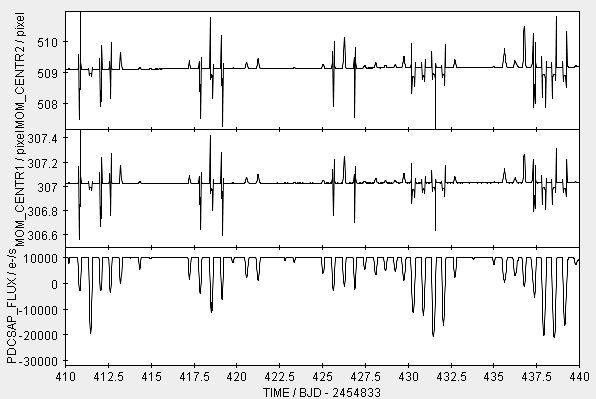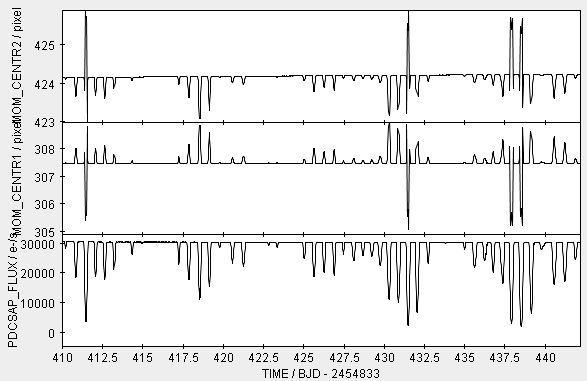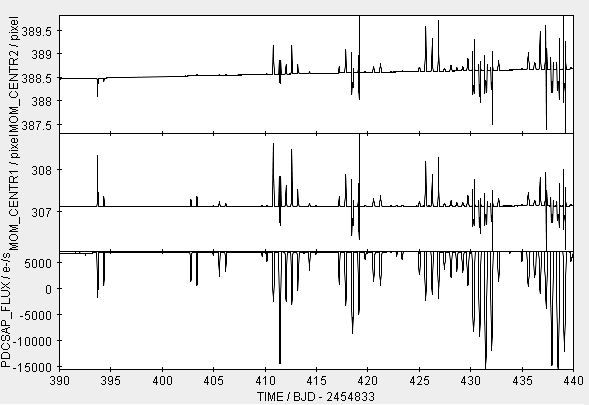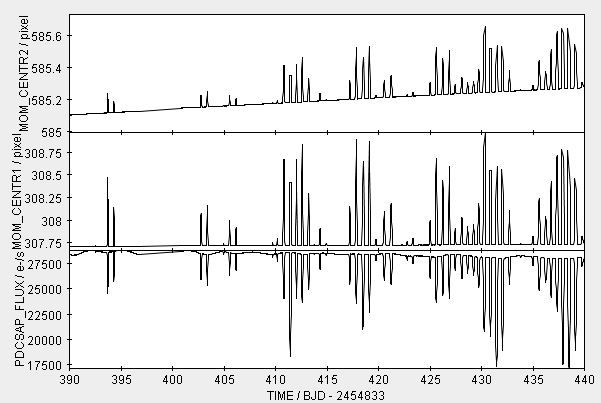Contaminated
-
 by
Vinokurov
by
Vinokurov
These features can be seen in Q4 - 8 - 12 and 16.
KID 4384652
KID 4384675
KID 4384793
KID 4482641
KID 4482348
Posted
-
 by
DZM
admin
by
DZM
admin
Well, that would certainly be noteworthy data if it were accurate. I suppose it's not? (not part of the science team, just curious)
[EDIT: This was poorly phrased! I meant that the data looked corrupted, but that if it wasn't, it would be a very interesting star.]
Posted
-
 by
Vinokurov
by
Vinokurov
A inconsiderate comment of you. You can check it out for yourself here: http://exoplanetarchive.ipac.caltech.edu/applications/ETSS/Kepler_index.html
If you look at the Q4 , Q8 , Q 12 and Q16 that I mention here ( http://talk.planethunters.org/#/subjects/APH00003du ) you will see yourself the contamination.
A minimum of respect. I have spent looking more contaminated objects and try to find the source of contamination, and you?
Posted
-
 by
DZM
admin
by
DZM
admin
@Vinokurov, my sincerest apologies, I did not mean anything like that, certainly no disrespect to you! Despite the admin tag, I'm quite new to astronomy, and I have no doubt that you are 100% correct about the contamination. I see it quite clearly in those quarters, and it's a good find.
Please explain to a clueless newbie: does this mean that the data is contaminated? What I meant to say, and clearly I phrased it very badly, was that it would be extremely interesting if the star's brightness really were fluctuating that quickly. Is it? Is the star itself contaminated? Or is the data inaccurate? (I am certain that you are completely accurate!)
Again, I apologize for my extreme ignorance and for my poor phrasing!
Posted
-
 by
mschwamb
scientist
in response to Vinokurov's comment.
by
mschwamb
scientist
in response to Vinokurov's comment.
Hi Vinokurov,
I'm glad to see you reporting contamination on the new Planet Hunters site and that you made the transition to new Talk. I hope you're liking the new changes. I don't think there were any ill intentions by DZM here, and that it was just a miscommunication.
I wanted to give you some more background. Admin status is typically Zooniverse web developers and Zooniverse team members, so DZM's not part of the science team. He's not an astronomer, so he doesn't know about contamination in Kepler light curves. He's new to the Zooniverse and learning all about Planet Hunters and the other Zooniverse projects. You can learn more about what his role in the Zooniverse is here.
Cheers,
~Meg
Posted
-
 by
mschwamb
scientist
by
mschwamb
scientist
Hey DZM,
Kepler is really good at measure the brightness of stars really precisely, but it's vision is very blurry. So the light curve for a star that is measured typically can have stars nearby to the target star contributing starlight. So what you're seeing as a Kepler light curve can be a combination of several stars. We call the neighboring stars contaminating the Kepler light curve.
If the surrounding stars are very bright, they dilute the Kepler light curve and planet transits looks shallower. and you estimate a smaller planet size when the planet is actually bigger. Additionally if the main star is an eclipsing binary (two stars going in front and behind each other creating a big dip little dip pattern typically) the eclipses will look smaller and you might not see the smaller dip and think this is a planet. Also you can have one of the neighboring stars be an eclipsing binary and have the same situation where sometimes you'll miss the secondary eclipse because it's diluted and think it is a planet.
In this case, in Quarters 4, 8, and 12 Vinokurov is pointing out that you can see an eclipsing binary signal (looks like it might be an EB to me) or some other variable signal that's not there in the other quarters and so likely there is heavy contamination in the light curve from a neighboring.. During the Kepler field observations, Kepler had to rotate in order to illuminate it's solar panels each quarter (so every 4 quarters the Kepler star falls back on the same CCD and the number of pixels added up to make the star varies per CCD), so that's why you see this signal appear every 4th quarter. In the in between quarters, the pixels added together don't include this contaminating star as significantly.
We haven't talked about contamination in a long while and with the relaunch we probably have some new people, so I'll try to write a blog post about stellar contamination in Kepler light curves.
You can read about some of our old blog posts about contamination and some of the checks we can do for planet candidates
- http://blog.planethunters.org/2012/06/08/turning-a-planet-candidate-into-a-bona-fide-planet/
- http://blog.planethunters.org/2011/09/26/adaptive-optics-follow-up-observations/
- http://blog.planethunters.org/2012/10/18/the-road-to-characterizing-ph1-the-overview/
- http://blog.planethunters.org/2012/10/16/the-road-to-characterizing-ph1-visual-band-imaging/
Cheers,
~Meg
Posted
-
 by
Vinokurov
by
Vinokurov
Do not worry about anything. I apologize too, this type of communication is not the most appropriate on these occasions. I was a bit angry at that momento. I would have liked to answer before but I've had a problem with Firefox and Nginx.
Posted
-
 by
DZM
admin
by
DZM
admin
Thank you for educating me, Meg. I'm hoping to learn something new every day on these boards, and this certainly qualifies... now I know a little about contamination! (I'm also learning to be very careful with my wording, and to be sure to keep the discussion appropriate for where it is taking place. 😃 )
I really appreciate everyone being patient with me while I learn how things work around here. Thank you all very much!
Posted
-
Vinokurov is right the KIDs mentioned above are all contaminated, here are the APOs for each KID in Q4:
KID 4482641:

KID 4384652:

KID 4384675:

KID 4384793:

KID 4482348:

Posted
-
A couple of weeks ago I worked a bit with SkyView hoping that the search field could be narrowed down. It was not that simple. I will try once again this week to upload a visualization of where these KIDs are located. If I remember correctly, the intuitive contamination sources were unfortunately not Kepler targets.
Posted
-
 by
Vinokurov
by
Vinokurov
KIDs mencioned are far from each other. I've done some searches, but it is not easy. The star that we seek may be far away or may not be listed.
Posted
-
 by
mschwamb
scientist
by
mschwamb
scientist
Hi,
I finally got around to writing that contamination blog post that I promised to write. If you're interested, you can find it here.
Cheers,
~Meg
Posted
-
 by
Vinokurov
by
Vinokurov
Hi Meg,
It was not necessary. Even so, very good information.
Good Hunting!
Posted